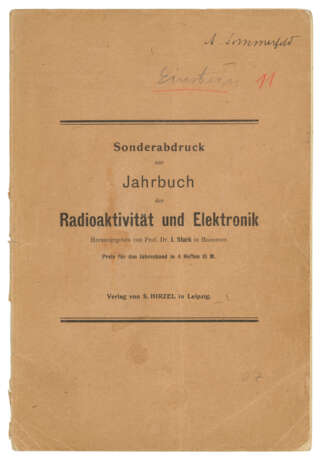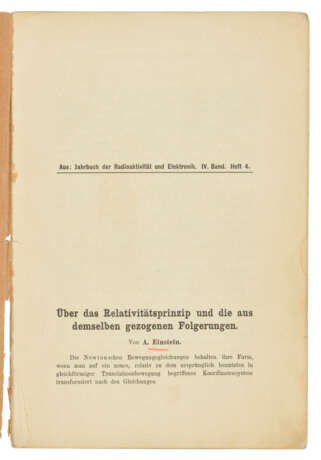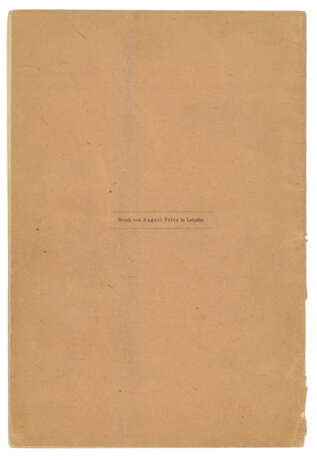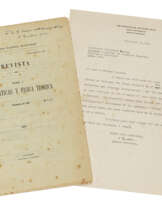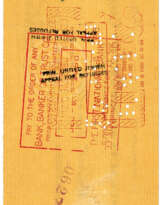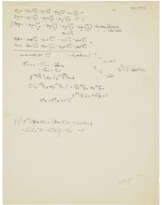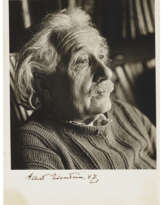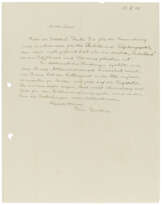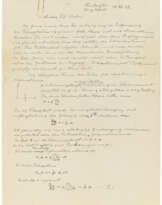ID 1349691
Lot 156 | EINSTEIN, Albert (1879-1955)
Estimate value
£ 15 000 – 20 000
‘Über das Relativitätsprinzip und die aus demselben gezogenen Folgerungen’. Offprint from: Jahrbuch der Radioaktivität und Elektronik. No. 4. Leipzig: S. Hirzel, 1908
Rare first edition, offprint issue, of Einstein's transitional paper from the special to the general theory of relativity. From the library of pioneering theoretical physicist Arnold Sommerfeld (1868-1951).
This paper marked the beginning of Einstein's conceptualization of gravity not as a force, but as a geometric property of spacetime - a revolutionary idea that would be fully realized in his 1915 theory of general relativity. Many of the predictions made in this paper, such as gravitational time dilation and the bending of light by gravity, were later confirmed experimentally, providing strong support for Einstein's theories.
Einstein wrote that when he was working on this paper, ‘There occurred to me the happiest thought of my life, in the following form. The gravitational field has only a relative existence in a way similar to the electric field generated by magnetoelectric induction. Because for an observer falling freely from the roof of a house there exists -at least in his immediate surroundings-no gravitational field’ [Einstein's emphasis]. Years later, in a lecture in Kyoto, Einstein recalled when the ‘happiest thought’ occurred to him: ‘I was sitting in a chair in the patent office at Bern when all of a sudden a thought occurred to me. “If a person falls freely he will not feel his own weight!” I was startled. This simple thought made a deep impression on me. It impelled me toward a theory of gravitation’.
Arnold Sommerfeld was a German theoretical physicist who made significant contributions to atomic and quantum physics. He extended Niels Bohr's atomic model by introducing elliptical orbits for electrons and proposed additional quantum numbers, including the azimuthal and magnetic quantum numbers. Sommerfeld also introduced the fine-structure constant, contributed to X-ray wave theory, and co-discovered the Sommerfeld-Wilson quantization rules. His seminal work Atombau und Spektrallinien became a foundational text for the new generation of physicists developing atomic and quantum physics. Sommerfeld was an exceptional educator, mentoring 7 Nobel Prize winners and numerous other prominent physicists. Despite being nominated for the Nobel Prize a record 84 times, he never received the award. Nevertheless, he was honoured with several prestigious accolades, including the Lorentz Medal, the Max-Planck Medal, and the Oersted Medal, and was elected to numerous scientific academies worldwide. In 1918, Sommerfeld succeeded Einstein as chair of the Deutsche Physikalische Gesellschaft, and in 1922 Einstein wrote to his successor: ‘What I especially admire about you is that you have, as it were, pounded out of the soil such a large number of young talents’ (A. Pais, ‘Subtle is the Lord...’: The Science and Life of Albert Einstein, 1982).
Extremely rare: we have not been able to trace any copy of this offprint appearing at auction (RBH/ABSAA). Weil *21; not in BRL.
Octavo (230 x 157mm). Paginated [411]-462 (purple stain to p.418). Original printed wrappers (loss to lower half of spine, some marks and creasing, pencil underlining, lettering and numbering to upper wrapper). Provenance: Arnold Sommerfeld (1868-1951; ownership inscription on upper wrapper, a few annotations in pencil and ink).
| Artist: | Albert Einstein (1879 - 1955) |
|---|---|
| Place of origin: | Western Europe, Germany, Europe |
| Auction house category: | Books and manuscripts, Printed books |
| Artist: | Albert Einstein (1879 - 1955) |
|---|---|
| Place of origin: | Western Europe, Germany, Europe |
| Auction house category: | Books and manuscripts, Printed books |
| Address of auction |
CHRISTIE'S 8 King Street, St. James's SW1Y 6QT London United Kingdom | |
|---|---|---|
| Preview |
| |
| Phone | +44 (0)20 7839 9060 | |
| Buyer Premium | see on Website | |
| Conditions of purchase | Conditions of purchase |
